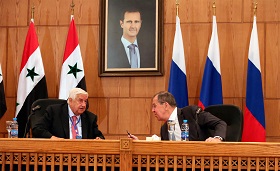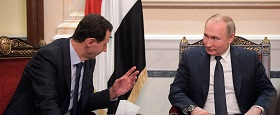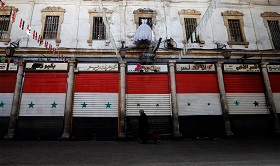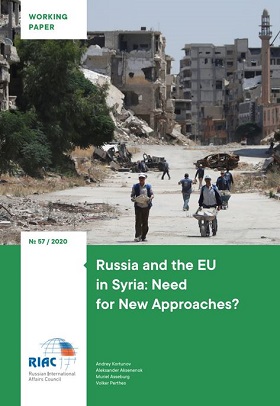The ninth year of internal armed conflict has brought new challenges to Syria. According to data from the United Nations Economic and Social Commission for Western Asia published on September 23, 2020, the damage done to the Syrian economy by the end of 2019 exceeded USD 442 bn. Still, under sanctions and with no international consensus on how to finance recovery, the country has not only failed to overcome the acute economic crisis but has also been hit by the negative consequences of the coronavirus pandemic, compounded by an unstable situation in neighbouring Lebanon. And, just as in the dry 2000s, these challenges have been aggravated by natural disasters, with earthquakes and forest fires raging across the country.
Clearly unable to handle these multiple challenges alone, Damascus is counting on assistance from Iran and Russia. Tellingly, the local political establishment and expert community are debating the prospects for Russia and Iran attaining a “balance of influence” in light of the results of the upcoming presidential elections in the United States. It is predicted that, if Donald Trump prevails, Iranian potential will remain hampered by sanctions, while a Joe Biden victory might cause Washington to return to the Joint Comprehensive Plan of Action (nuclear deal) and, as a consequence, strengthen Iranian economic presence in Syria. Is it any surprise then that the active exchange of delegations between Russia and Syria in September and October 2020 (the visit to Damascus by Co-Chair of the Permanent Russian-Syrian Intergovernmental Commission on Trade, Economic, Scientific and Technical Cooperation (IGC) Yuri Borisov and Minister of Foreign Affairs Sergey Lavrov and the return visit by a Syrian delegation headed by Minister of Presidential Affairs Mansour Azzam; as well as the trips to Damascus by Chairman of the Investigative Committee of Russia Alexander Bastrykin and Chief Military Prosecutor Valery Petrov) is regarded as an attempt by Moscow to create a safety net by strengthening its control over Syria in terms of both economics and security.
Admitting that there is a reasonable element to these statements, it seems to be time for Russia to decide on an economic strategy in Syria. Should we continue to rely mainly on big private companies with experience in the Middle East (in this case, Stroytransgaz) or rather adopt a specialised federal programme led by the IGC? Yuri Borisov’s visit may be viewed precisely from this angle. The latter course of action would allow future potential to be created on the basis of a systematic approach, including in the light of the competitive partnership with the Iranians. Moscow is able to help Damascus in the fight against COVID-19 and help restore the economic unity of Syria. Many experts saw this as the reason for Sergey Lavrov's visit to Damascus; earlier, on August 31, 2020, he received a Kurdish delegation to Moscow headed by Co-Chairman of the Executive Council of the Syrian Democratic Council Iham Ehmed.
The ninth year of internal armed conflict has brought new challenges to Syria. According to data from the United Nations Economic and Social Commission for Western Asia published on September 23, 2020, the damage done to the Syrian economy by the end of 2019 exceeded USD 442 bn. Still, under sanctions and with no international consensus on how to finance recovery, the country has not only failed to overcome the acute economic crisis but has also been hit by the negative consequences of the coronavirus pandemic, compounded by an unstable situation in neighbouring Lebanon. And, just as in the dry 2000s, these challenges have been aggravated by natural disasters, with earthquakes and forest fires raging across the country.
Violation of Territorial Integrity: A Brake on Restoration
Even though government forces managed to win back half of "Greater Idlib," which includes Idlib itself and the surrounding parts of the governorates of Aleppo, Latakia and Hama (the rebel-controlled zone reduced from 7,000 sq. km in April 2019 to 3,000 sq. km in March 2020), Damascus is still unable to regain all its territories and reconsolidate the economy.
Since the ISIS “caliphate” was broken up, “parallel economies” have continued to exist in Idlib (led by the “Syrian Salvation Government” established by the radical Islamist group Hayat Tahrir al-Sham) and the Turkey-controlled “buffer zone” in the North (formally under the authority of the opposition “Provisional Government” of Syria), not to mention the Kurdish “Autonomous Administration of North and East Syria” (AANES). Attempts by the United States to “conserve” this economic fragmentation by gaining access to local natural resources through its Kurdish allies have long become a headache for the country’s central authorities. A recent example from July 2020 was when AANES (despite protests by Damascus and Ankara) signed an agreement with Delta Crescent LLC, a company registered in the U.S. state of Delaware, on development of oil fields in the Syrian Trans-Euphrates area.
Lebanese Crisis: Negative Consequences for Syria
Another challenge for Damascus has been the growing internal crisis in neighbouring Lebanon. It has weakened the Syrian national currency and reduced potential investments in the recovery of the Syrian economy; more fuel was added to the fire when two explosions rocked the port of Beirut on August 4, 2020, knocking out a key transhipment point for Syria’s trade with the Gulf countries. Alternative routes are problematic owing to the lower throughput capacity of the northern Lebanese port of Tripoli (almost 90% less than that of the Beirut port) and, most importantly, the unwillingness of international trade and transport companies to use the Syrian ports of Latakia and Tartus to channel direct supplies to Syria, much less for transit to Lebanon (owing to the sanctions). Predictably, Syria’s imports have dropped and the prices of food and other imported goods gone up as a result of the high sanctions risks and increased cost of logistics services.
Caesar Act: Real Sanctions
Unfortunately for Syria, the secondary U.S. sanctions under the "Caesar Act" quickly began turning into an effective mechanism (much unlike previous measures, often limited to the compilation of sanctions lists), although Washington is not going to abandon "paper" sanctions either: on September 30, 2020, the U.S. Department of the Treasury introduced a new list, including 13 legal entities and seven individuals, one of them the Governor of the Central Bank of Syria.
The prospect of criminal prosecution in the United States for using the American financial system in the interests of Syria and for inciting American citizens and companies to violate the sanctions regime has become a particular concern for Syrians’ business partners. Many decided to play it safe. For example, on July 8, 2020, Amazon, the biggest American e-commerce platform, decided to pay the U.S. Treasury retroactively a voluntary sum of 134,523 U.S. dollars for supplying goods and services to Syria (as well as to the sanctioned Iran and Crimea) for the period from November 5, 2011, to October 18, 2018.
In seemingly friendly Lebanon, which is in dire need of Western donor assistance to overcome its own crisis, the authorities seem to be ready to do anything to avoid falling under the "Caesar sanctions". For example, on September 6, 2020, local customs officers arrested a vessel with 4 million litres of petrol destined for Syria. This gesture was not ignored on Capitol Hill: on September 28, U.S. Senators Jeanne Shaheen, Chris Murphy and Tim Kaine called on Secretary of State Mike Pompeo not to punish Lebanon for buying electricity from the Syrians.
The effectiveness of “Caesar sanctions” is recognised by the Syrians themselves. In September 2020, Western media quoted Minister of Oil and Mineral Resources Bassam Toum as blaming the Americans for creating energy shortages in his country (now, according to existing estimates, the Syrian need for crude oil is 100,000–136,000 barrels a day compared with daily production of 24,000 barrels). Local economists point out that sanctions-related power outages have hit industries, primarily in Aleppo. The energy crisis forced the government to take unpopular measures. On October 4, 2020, it raised the price of non-subsidised 95-octane petrol from 575 to 850 Syrian pounds per litre (i.e., from 46 to 68 cents), and then raised the price of subsidised 90-octane petrol from 250 to 450 Syrian pounds (i.e., from 20 to 36 cents).
Coronavirus Pandemic: Numbers and Reality
At first glance, the COVID-19 statistics in Syria look more optimistic than those of neighbouring countries. For example, in terms of the number of cases (fewer than 6,000), the proportion of infected individuals in the population (0.03%) or the country’s 129th place in the world ranking (see the table compiled by the author based on data for 18 and 23 October 2020, taken from coronavirus-control.ru):
COVID-19 in Syria and Neighbouring Countries

The good indicators are partly explained by the fact that wartime Syria under sanctions has been a closed country compared to the more open Israel, Lebanon and Turkey, this reducing the objective risk of infection. Even after Damascus International Airport (which had not functioned since March) was opened on October 1, 2020, the number of scheduled flights remained small compared to Beirut Airport, which has become the gateway to the outside world for many Syrians. Passengers are required to provide COVID-19 test results on arrival and departure. Many official border crossing points in Syria are still closed, which is also holding back the spread of COVID-19.
Syria is receiving foreign aid to combat the pandemic, including from China, the UAE and Russia. A total of 1.5 million medical and 67,848 respiratory masks, as well as 1.3 million pairs of gloves, were delivered through the World Health Organization. Syrian authorities are working to establish national production of medicines, such as azithromycin, which is included in the treatment protocol for COVID-19.
Yet the optimistic indicators underplay existing problems, which are made apparent by more statistics: Syria surpasses all neighbouring countries in terms of COVID-19 mortality (almost 5%), while the percentage of recovered patients (slightly more than 31%) is significantly lower than that of its neighbours, excluding Jordan.
As the territorial integrity of Syria has been disrupted, it is difficult to organise a nationwide campaign to combat the pandemic. The extremely modest numbers of cases in AANES-controlled areas and in Idlib (which are not accounted for in the official Syrian statistics) – even though the first cases were reported in April and July 2020, respectively – hardly reflect the real state of affairs. Some places are affected by armed confrontation: for example, in mid-August, pro-Turkish groups based near the city of Ras al-Ayn in northeastern Syria cut off the water supply to the provincial centre of Al-Hasakah located in the AANES zone. UN officials described this incident as using “water as a weapon of war.”
Medical experts draw attention to the possible movement of individuals across informal border posts without complying with anti-pandemic requirements, including COVID tests. Experts also point out a shortage of medical facilities and COVID-19 detection kits (it is not uncommon for private medical centres to refuse admission to uninsured coronavirus patients), as well as the reluctance of many patients to seek medical help for fear of losing their jobs (according to the Ministry of Social Affairs and Labour, more than 320,000 Syrians have lost their jobs as a result of quarantine measures). UN experts are sounding the alarm because of the lack of funding for measures to stop the spread of COVID in Syria: no more than USD 55.6 million has been raised so far, out of the USD 188.6 million required.
Forest Fires
A subjective factor in the deterioration of the socio-economic situation was the unprecedented scale of the forest fires that swept through the mountainous regions of western Syria in September and October 2020. According to local law enforcement, those fires may have been deliberately set by terrorists or criminal groups. According to the United Nations Office for the Coordination of Humanitarian Affairs, from 8 to October 11 alone, 156 fires in the provinces of Latakia, Tartus and Homs destroyed 9,000 hectares of agricultural and forest land, causing displacement of 25,000 people. According to local experts, this damage temporarily overshadowed the negative impact of armed clashes, sanctions and the pandemic.
Anti-Crisis Consolidation of National Resources
Despite all the problems, the Syrian authorities are striving to respond to all the challenges of the crisis agenda, combining fiscal measures that seek new sources of budget revenues with the semi-voluntary raising of financial resources from the private sector, accompanied by administrative support for national business and populist steps to preserve the loyalty of the population.
For example, on July 8, 2020, Prime Minister Hussein Arnous signed Resolution 46/2020, obliging Syrian citizens (with the exception of minors, truck and public transport drivers) entering Syrian territory to exchange the equivalent of USD 100 for Syrian pounds. This decision caused an uproar, however, as it violates the provisions of the current Constitution of 2012 (Article 38 states that no Syrian citizen may be prevented from returning to the country), which forced the authorities to introduce concessions for low-income citizens.
Mobilising private sector resources through campaigns for social responsibility and against corruption remains a priority for the government. In July 2020, the customs authorities stopped clearing imported goods until the importers sell 15% of the goods to the public sector at cost. At the same time, in order to support the local industry in the release of anti-coronavirus drugs, Decree 14/2020 was adopted on July 13, completely exempting pharmaceutical raw material imports from customs duties for one year.
As part of a campaign against favouritism and corruption, supervised personally by the president, the authorities proceeded to liquidate Rami Makhlouf's vast "business empire," including his biggest asset in Syria, Sham Holding (a chain of duty-free shops) and Nur (a microfinance fund), with the aim of raising funds for anti-crisis measures. It is no coincidence that, in his speech before the newly elected People's Council (parliament) on August 12, 2020, Bashar Assad called corruption the main challenge for the country along with terrorism, repeating the same idea in his address to the new cabinet of ministers on September 1.
Declaring a consistent policy of promoting social security and combating speculation in essential commodities, in addition to the rationing of the petrol distribution system, the government introduced bread cards for residents of Damascus, the metropolitan area and Latakia in September. On October 21, the authorities lowered the progressive tax on personal income from 5–22% to 4–18% and announced a lump sum payment of 50,000 Syrian pounds (equivalent to USD 40) to civilian and military personnel. On October 13, Bashar Assad visited the north-western regions of the country, ordering the Ministry of Local Administration and Environment to allocate 2.37 billion Syrian pounds to restore the fire-affected communities in the governorates of Latakia and Tartus; a special account was opened in the Commercial Bank of Syria to help victims of the fires.
Russian Economic Aid to Syria
Clearly unable to handle these multiple challenges alone, Damascus is counting on assistance from Iran and Russia. Tellingly, the local political establishment and expert community are debating the prospects for Russia and Iran attaining a “balance of influence” in light of the results of the upcoming presidential elections in the United States. It is predicted that, if Donald Trump prevails, Iranian potential will remain hampered by sanctions, while a Joe Biden victory might cause Washington to return to the Joint Comprehensive Plan of Action (nuclear deal) and, as a consequence, strengthen Iranian economic presence in Syria. Is it any surprise then that the active exchange of delegations between Russia and Syria in September and October 2020 (the visit to Damascus by Co-Chair of the Permanent Russian-Syrian Intergovernmental Commission on Trade, Economic, Scientific and Technical Cooperation (IGC) Yuri Borisov and Minister of Foreign Affairs Sergey Lavrov and the return visit by a Syrian delegation headed by Minister of Presidential Affairs Mansour Azzam; as well as the trips to Damascus by Chairman of the Investigative Committee of Russia Alexander Bastrykin and Chief Military Prosecutor Valery Petrov) is regarded as an attempt by Moscow to create a safety net by strengthening its control over Syria in terms of both economics and security.
Admitting that there is a reasonable element to these statements, it seems to be time for Russia to decide on an economic strategy in Syria. Should we continue to rely mainly on big private companies with experience in the Middle East (in this case, Stroytransgaz) or rather adopt a specialised federal programme led by the IGC? Yuri Borisov’s visit may be viewed precisely from this angle. The latter course of action would allow future potential to be created on the basis of a systematic approach, including in the light of the competitive partnership with the Iranians. Moscow is able to help Damascus in the fight against COVID-19 and help restore the economic unity of Syria. Many experts saw this as the reason for Sergey Lavrov's visit to Damascus; earlier, on August 31 2020, he received a Kurdish delegation to Moscow headed by Co-Chairman of the Executive Council of the Syrian Democratic Council Iham Ehmed.









